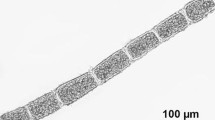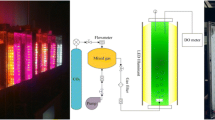Summary
-
1.
An automatic test was applied to populations of Euglena gracilis without disturbing the free running rhythm. This test allows to distinguish between the mobility in darkness and the phototactic response in a light trap. The parameters of the rhythm are better represented by the mobility.
-
2.
In mixotrophic cultures the free running frequency decreases with increasing values of constant temperature, while the phase is not affected by sudden temperature changes. A sudden temperature drop temporarily decreases the amplitude; a steplike increase in temperature does not significantly change the amplitude.
-
3.
In autotrophic cultures the spontaneous frequency is independent of different values of constant temperature in the range between 15°C to 35°C. The length of the period is 23,5±0,3 hr. A sudden temperature increase of 5°C and more causes transitory increase of the frequency. The spontaneous frequency is reestablished in the form of an aperiodic logarithmic transient function. The phase shift depends on the phase at which the temperature increase was applied but does not depend on the height of the temperature step. Temperature drops affect the phase only when applied at phases which normally coincide with dawn. In these cases a sudden inversion without transients occurs. A temperature drop following a sudden temperature increase stops the transient function induced by the preceeding rise of the temperature. The amplitude depends on the temperature; the Q10 is about 2,7.
-
4.
The supposed biochemical basis of the different temperature responses under the different conditions of metabolism is discussed.
Similar content being viewed by others
Literatur
Aschoff, J., K. Klotter u. R. Wever: Cireadianer Wortschatz. In: J. Aschoff (ed.), Circadian clocks. Amsterdam 1965.
Bruce, V. G.: Environmental entrainment of circadian rhythms. Cold Spr. Harb. Symp. quant. Biol. 25, 371–378 (1960).
Bruce, V. G., and C. S. Pittendrigh: Temperature independence in a unicellular clock. Proc. nat. Akad. Sci. (Wash.) 42, 676–682 (1956).
——: Resetting the Euglena clock with a single light stimulus. Amer. Nat. 92, 295–306 (1958).
——: An Effect of heavy water on the phase and period of the circadian rhythm in Euglena. J. cell comp. Physiol. 56, 25–31 (1960).
Bünning, E.: Die physiologische Uhr, 2. Aufl. Berlin-Göttingen-Heidelberg: Springer 1963.
Chance, Br., B. Schoener, and S. Elsasser: Metabolic control phenomena involved in damped sinusiodal oscillations of reduced diphosphopyridine nucleotide in a cellfree extract of Saccharomyces carlsbergensis. J. biol. Chem. 240, 3170 bis 3181 (1965).
Hutner, S. H., and L. Provasoli: The phytoflagellates. In: A. Lwoff (ed.), Biochemistry and Physiology of Protozoa. New York: Wiley 1951.
Könitz, W.: Statistische Auswertungsmethoden. In: H. M. Rauen (ed.), Biochemisches Taschenbuch, Teil II, S. 959–1046. Berlin-Göttigen-Heidelberg: Springer 1964.
Leedale, C. F., B. J. D. Meeuse, and E. G. Pringsheim: Structure and physiology of Euglena spirogyra. Arch. Mikrobiol. 50, 68–102 and 133–155 (1965).
Palmer, J. D. and F. E. Round: Persistent vertical migration rhythms in bentic microflora. I. The effect of light and temperature on the rhythmic behaviour of Euglena obtusa. J. Mar. Biol. Ass. U. K. 45, 567–582 (1965).
Pittendrigh, C. S., and V. G. Bruce: An oscillator model for biological clocks. In: Rudnik (ed.) Rhythmic and synthetic processes in growth. Princeton: Princeton Univ. Press 1957.
Pohl, R.: Tegesrhythmus im phototaktischen Verhalten der Euglena gracilis. Z. Naturforsch. 3b, 367–374 (1948).
Siegel, S.: Nonparametric statistics for the behavioral sciences. New York-Toronto London: McGraw-Hill 1956.
Sollberger, A.: Biological rhythm research. Amsterdam-London-New York: Elsevier Pub. Comp. 1965.
Sweeney, B. M.: Rhythmicity in the biochemistry of photosynthesis in Gonyaulax. In: J. Aschoff (ed.) Circadian clocks. Amsterdam: North Holland Publ. Comp. 1965.
Wever, R.: Zum Mechanismus der biologischen 24-Stunden-Periodik. Kybernetik 1, 139–154 (1962).
—: Zum Mechanismus der biologischen 24-Stunden-Periodik. III. Mitt. Der Einfluß des Gleichwertes auf die Eigenschaften selbsterregter Schwingungen. Kybernetik 2, 127–144 (1964).
—: Einzelorganismen und Populationen im circadianen Experiment. Eine methodische Analyse. Z. vergl. Physiol. 51, 1–24 (1965).
Wilkins, M. B.: The influence of temperature and temperaturechanges on biological clocks. In: J. Aschoff (ed.), Circadian clocks. Amsterdam: North Holland Publ. Comp. 1965.
Wolken, J. J.: A molekular morphology of Euglena gracilis var. bacillaris. J. Protozool. 3, 211–221 (1956).
—: Euglena. An experimental Organism for Biochemical and Biophysical Studies. New Brunswick Rutgers Press 1961.
Author information
Authors and Affiliations
Rights and permissions
About this article
Cite this article
Brinkmann, K. Temperatureinflüsse auf die Circadiane Rhythmik von Euglena Gracilis bei Mixotrophie und Autotrophie. Planta 70, 344–389 (1966). https://doi.org/10.1007/BF00397315
Received:
Issue Date:
DOI: https://doi.org/10.1007/BF00397315




